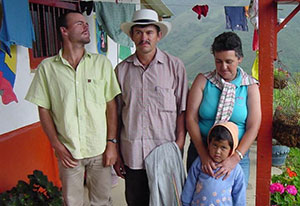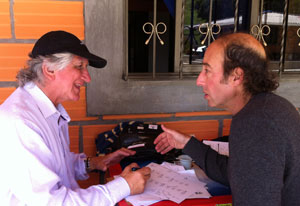Because of a lapse in government funding, the information on this website may not be up to date, transactions submitted via the website may not be processed, and the agency may not be able to respond to inquiries until appropriations are enacted. The NIH Clinical Center (the research hospital of NIH) is open. For more details about its operating status, please visit
cc.nih.gov. Updates regarding government operating status and resumption of normal operations can be found at
opm.gov.
Fogarty trainees study Colombian family for clues to prevent Alzheimer's
May / June 2017 | Volume 16, Issue 3

Photo courtesy of Dr. Yakeel Quiroz
Fogarty funding has helped develop scientific expertise
in rural Colombia, laying the groundwork for a clinical
trial of a drug that might slow progression of Alzheimer’s
that is being tested on members of an extended family
with an inherited early-onset form of the disease.
Research conducted in Colombia may provide clues on how to prevent the ravages of Alzheimer's disease - a global problem that in the U.S. alone could affect 16 million people and cost $1 trillion annually by 2050, according to the Alzheimer's Association.
Colombia has become significant to Alzheimer's research because it is home to the largest known family with an inherited, early-onset form of the disease. Some of the relatives are participating in an innovative Alzheimer's prevention trial to determine if a drug provided by a U.S.-based company can stave off the decline in memory and brain function associated with the disease.
Fogarty helped set the stage for the trial by supporting the training of Colombian scientists in cutting-edge neuroscience research. Building in-country expertise in brain tissue analysis, advanced microscopy and genetics, for example, created a cadre of scientists equipped to conduct a large clinical trial.
The Alzheimer's prevention study is the first to focus on people who are cognitively healthy but at extremely high risk of developing the disease. The research reflects new thinking that testing therapies before impairment occurs might be most effective. The Colombian clan is at the center of the research because a rare genetic mutation runs in the family - people who harbor it typically develop noticeable symptoms of Alzheimer's around age 45. The
NIH-supported trial, begun in 2013, is a collaboration among the University of Antioquia in Colombia, Banner Alzheimer's Institute in Phoenix, and Genentech, a San Francisco-based biotech company that is supplying the test drug, crenezumab.

Photo courtesy of Dr. Kenneth Kosik/UCSB
A longtime collaboration between Colombian
neuroscientist Dr. Francisco Lopera (left) and
Dr. Kenneth Kosik, of University of California, Santa
Barbara, is advancing Alzheimer's research.
"There's no doubt in my mind the clinical trial wouldn’t have happened if it weren’t for Fogarty getting in there and building capacity," says Dr. Kenneth Kosik, a neuroscientist and professor at the University of California, Santa Barbara. Kosik has been studying the Colombian family since the 1990s with his longtime collaborator, Dr. Francisco Lopera, chief of neuroscience at the University of Antioquia. It was Lopera who discovered the early-onset Alzheimer’s family in the 1980s when, as a neurology resident, he met a patient who lost his memory in his 40s, just like his father and grandfather. Over the years, the scientists discovered the genetic mutation responsible for the disease, identified more than 5,000 members of the extended family and explored possible gene therapy targets for Alzheimer’s.
For nearly a decade, Fogarty and NIH’s National Institute on Aging (NIA) co-funded investigations and training that helped establish a neuroscience research program at the University of Antioquia. "If there's one thing I think we accomplished, it was creating a strong scientific community there interested in neurodegeneration, a local community that is the foundation for a big clinical trial."
Alzheimer’s may be "just the tip of the iceberg," says Kosik, noting there are more large families in Colombia's Antioquia region with other inherited neurodegenerative conditions, such as Huntington's. The university's biobank of postmortem brain tissue provides another opportunity for discovery, Kosik says. "We've only just begun to tap the resources that are available there, and the local talent, in terms of the genetic secrets that lie in that population."
More Information
To view Adobe PDF files,
download current, free accessible plug-ins from Adobe's website.